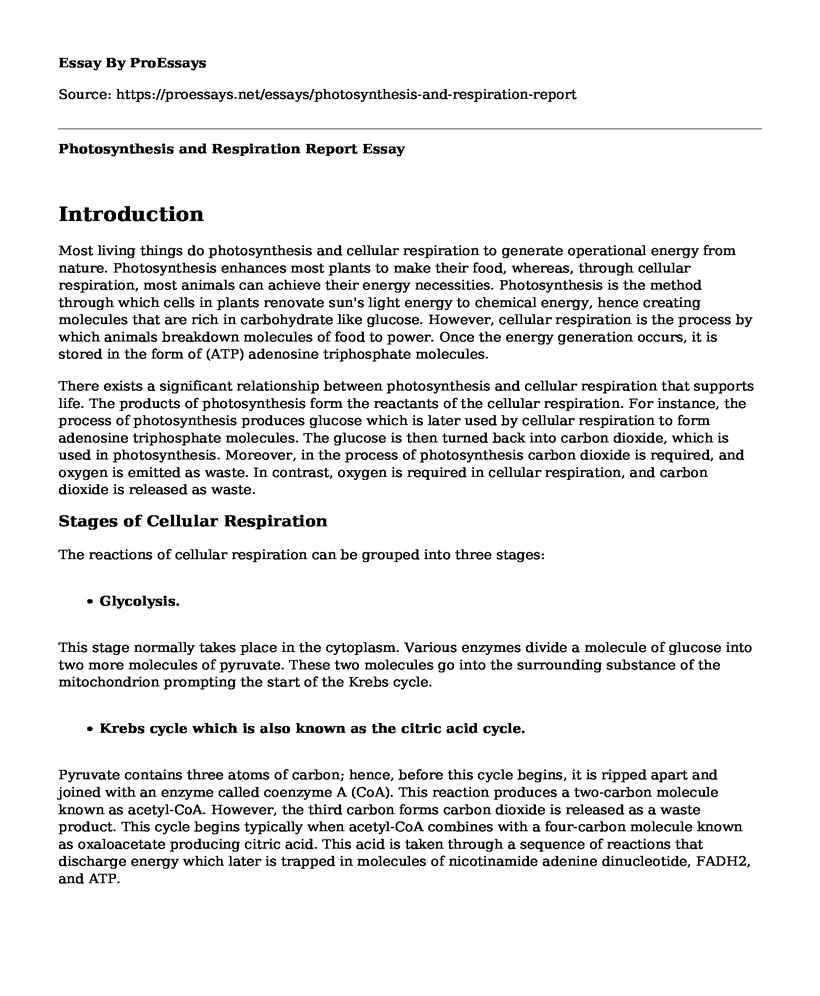Introduction
Most living things do photosynthesis and cellular respiration to generate operational energy from nature. Photosynthesis enhances most plants to make their food, whereas, through cellular respiration, most animals can achieve their energy necessities. Photosynthesis is the method through which cells in plants renovate sun's light energy to chemical energy, hence creating molecules that are rich in carbohydrate like glucose. However, cellular respiration is the process by which animals breakdown molecules of food to power. Once the energy generation occurs, it is stored in the form of (ATP) adenosine triphosphate molecules.
There exists a significant relationship between photosynthesis and cellular respiration that supports life. The products of photosynthesis form the reactants of the cellular respiration. For instance, the process of photosynthesis produces glucose which is later used by cellular respiration to form adenosine triphosphate molecules. The glucose is then turned back into carbon dioxide, which is used in photosynthesis. Moreover, in the process of photosynthesis carbon dioxide is required, and oxygen is emitted as waste. In contrast, oxygen is required in cellular respiration, and carbon dioxide is released as waste.Stages of Cellular Respiration
The reactions of cellular respiration can be grouped into three stages:
-
Glycolysis.
This stage normally takes place in the cytoplasm. Various enzymes divide a molecule of glucose into two more molecules of pyruvate. These two molecules go into the surrounding substance of the mitochondrion prompting the start of the Krebs cycle.
-
Krebs cycle which is also known as the citric acid cycle.
Pyruvate contains three atoms of carbon; hence, before this cycle begins, it is ripped apart and joined with an enzyme called coenzyme A (CoA). This reaction produces a two-carbon molecule known as acetyl-CoA. However, the third carbon forms carbon dioxide is released as a waste product. This cycle begins typically when acetyl-CoA combines with a four-carbon molecule known as oxaloacetate producing citric acid. This acid is taken through a sequence of reactions that discharge energy which later is trapped in molecules of nicotinamide adenine dinucleotide, FADH2, and ATP.
-
Electron transport.
The energy resulting from the Krebs cycle is transferred to ATP, and as the high-energy electrons have been transferred through the shackles, some amount of energy is captured.
The three stages of cellular respiration produce various numbers of molecules. In glycolysis stage, two ATP molecules are produced, and the Krebs cycle produces two more molecules. The final stage of electron transport starts with multiple molecules acquired from the citric acid cycle and transports the molecular energy to as many as thirty-four more molecules of adenosine triphosphate.
Stages of Photosynthesis
The process of photosynthesis takes place in four stages namely:
-
Absorption of light.
The first stage of photosynthesis is the absorption of light by the chlorophyll. In this stage, the energy acquired from the absorbed light is required to confiscate electrons that form oxygen and then it is later used to transfer the electrons to a prime electron acceptor.
-
Electron Transport.
The transfer of electrons is attached to the transportation of the protons generated from the stroma to the thylakoid lumen, creating an incline within the membrane.
-
Generation of ATP.
Protons shift down their concentration incline from the thylakoid lumen to the stroma, which attaches the proton progress to the synthesis of ATP.
-
Carbon fixation.
The reactions that generate the ATP and NADPH used in carbon fixation are directly dependent on light energy.
Cellular respiration and photosynthesis typically occur in unique organelles. Photosynthesis usually takes place in the chloroplasts, whereas cellular respiration takes place in the mitochondria. Photosynthesis usually takes place in plants, and animals do cellular respiration. However, plants experience cellular respiration at night through the mitochondria. Since they can acquire sunlight needed for photosynthesis, they respirate with the help of sugars in storage.Conclusion
In conclusion, both photosynthesis and cellular respiration are essential for human survival. Photosynthesis is the original source of oxygen in the atmosphere. It also contributes to the carbon cycle between living things. On the other hand, cellular respiration provides the energy needed by living things to perform day to day activities.
Cite this page
Photosynthesis and Respiration Report. (2022, Feb 21). Retrieved from https://proessays.net/essays/photosynthesis-and-respiration-report
If you are the original author of this essay and no longer wish to have it published on the ProEssays website, please click below to request its removal:
- Animals Rights and Wrong by Rodger Scruton Essay Example
- Essay Sample on Animal Cloning
- Keeping Animals in Zoos Should Be Banned for Life - Essay Sample
- Children Nerves System
- Essay Example on Altering Genomes: A Practice Since Generations
- Free Report Example on Aphasia: Understanding the Neurolinguistic Disorder
- How Wolves Change Rivers - Movie Review Sample







